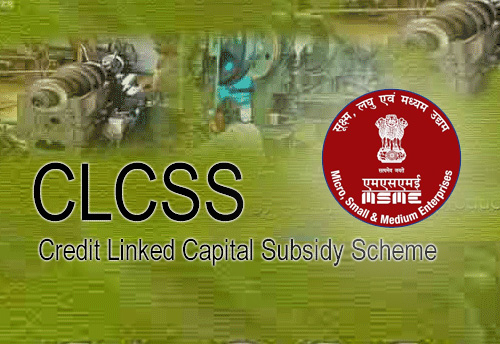
Credit Linked Capital Subsidy for Technology Upgradation
Date : 19.December.2018Micro, Small and Medium Enterprises (MSMEs) play a vital role in the Indian Economy. It is a catalyst for socio-economic transformation of the country, as it enables in meeting of national objectives like generating employment, reducing poverty and discouraging rural-urban migration. These enterprises help to build a thriving entrepreneurial eco-system, and promote the use of indigenous technologies. They provide comparatively large employment opportunities at lower capital cost than large industries and also help in industrialization of the rural areas.
Seeing that this sector has showcased consistent growth over the last few years, and still has inadequate access to financial resources, Government of India wanted to ensure that credit is made available to this sector at lower interest rate. Through the introduction of Non-Banking Financial Institutions like www.prestloans.com cheaper loans were disbursed through quickly and with much lesser paperwork. GOI launched numerous schemes like Prime Minister's Employment Generation Programme (PMEGP), Credit Guarantee Fund Trust Scheme for Micro and Small Enterprises, Pradhan Mantri Mudra Yogna (read more about it at our blog https://bit.ly/2KfS3WL%20 )
Introduction :GOI noticed that a large percentage of MSME enterprises continue to operate with outdated technology and plant & machineries. This is because many of the MSME are not aware regarding quality standards and even if they are aware, lack of access to modern technologies and lack of funds hinder them from upgrading their enterprises to match global industrial standards. But in order to survive in this competitive world, they need to be modernized to ensure that cost of production goes down.
This prompted GOI to launch another scheme by the name of Credit Linked Capital Subsidy for Technology Upgradation (CLCS_TU).
Salient features
-
This scheme was launched on 1st October 2010.
-
This scheme aims at facilitating technology upgradation by providing 15% upfront capital subsidy to MSE units (including tiny, khadi, village and coir industrial units) on institutional finance availed of them on induction of well-established and improved technologies in specific sub-sectors/products approved under the scheme. (See https://bit.ly/2MWGFh2 for more details on list of approved technologies and specific sub-sectors/products)
-
Technological upgradation means induction of state-of-the-art technology or near state-of-the-art technology. This would result in:
-
Improved productivity
-
And/ improvement in quality of products –through introduction of in-house testing techniques and on-line quality control
-
And/ improved environmental conditions, anti-pollution measures, energy conservation machinery
-
And/improved packaging techniques
-
-
Earlier only 12% capital subsidy was provided, however, considering the need of the hour, GOI increased the limit to 15%.
-
The ceiling of loans was increased from Rs. 40 lakhs to Rs. 1 crore.
-
Admissible capital subsidy is now calculated with reference to purchase price of plant and machinery; instead of term loan disbursed to beneficiary unit.
-
These changes were implemented retrospectively from 29th September, 2005.
-
Eligible Beneficiaries
-
These include sole Proprietorships, Partnerships, Cooperative societies, Private and Public limited companies in the MSME sector. Amongst these, women entrepreneurs shall be accorded priority
-
Industry graduating from small scale to medium scale on account of sanction of additional loans under CLCSS
-
MSMEs that have graduated from small scale industry in the last 3 years
-
Existing units registered with State directorate of Industries, which upgrade their existing plant and machinery with state-of-the-art technology, with or without expansion
-
New units which are registered with State directorate of Industries and have set up their facilities only with the appropriate eligible and proven technology duly approved by Governing and Technology Approval Board/ Technical Sub-Committee (GTAB/TSC)
-
Beneficiary unit shall continue commercial production for atleast 3 years after availing CLCSS subsidy
-
Procedure of disbursement
-
MSMEs are required to approach Prime Lending Institution (PLI) (i.e. banks/financial institutions) and file an online application. (see https://bit.ly/2MWGFh2 for more details)
-
This application is sent to Nodal Agency (Small Industries Development Bank of India (SIDBI) and National Bank for Agriculture and Rural Development (NABARD) who then sends it along with it recommendation to office of Development Commissioner, MSME.
-
After processing and subject to availability of funds, due approval is accorded and concurrence is also obtained from Internal Finance Wing.
-
Thereafter, funds are released to Nodal Agencies, and then from Nodal Agency to PLIs where the account of MSE is operated.
-
Subsidy amount is released with each loan instalment in a manner proportionate to the amount of term loan disbursed (on pro-rata basis)
Performance of CLCSS
Performance of Credit Linked Capital Subsidy Scheme (CLCSS) from the inception (2001-02) upto 2016-17 is given below:
|
Year |
No. of MSE Beneficiaries |
Total Amount of subsidy released (Rs. Crore) |
|
2001-02 to 2011-12 |
16295 |
854.05 |
|
2012-13 |
5713 |
343.79 |
|
2013-14 |
6279 |
421.48 |
|
2014-15 |
7246 |
448.85 |
|
2015-16 |
5047 |
322.44 |
|
2016-17 |
4011 |
256.53 |
|
2017-18 (Upto 30.09.2017) |
4027 |
257.39 |
Conclusion :MSMEs contribute 32% of Gross Value added (GVA) and pave way for industrialization in rural and backward areas. According to National Sample Survey (2015-16), 633.8 lakh unincorporated non-agricultural MSMEs provide employment to 11.10 crore workers in the country, but the percentage or credit they receive is not commensurate. The Economic Survey 2017-18 clearly showed that MSMEs are handicapped by dearth of credit to expand their business.
Traditionally, banks hesitated to grant loans to MSMEs due to myriad of reasons like their high risk factor owing to their unorganized nature; their lack of eagerness to get themselves rates; their inconsistent cashflow; their lack of formal accounts etc. In order to bridge this gap and to ensure MSME’s smooth transition from informal to formal sector, NBFCs (Non-Banking Financial Institutions) like www.prestloans.com; were set up by government of India. This was also done to remove financial roadblocks faced by MSMEs. Compared to banks, NBFCs have gained a better understanding of their customer base and are now better equipped in profiling their customers. This is probably the reason as to why majority of the Public Sector Banks are grappling with high NPAs, whereas NBFCs magnitude of this problem is miniscule.
Source
Leave a Comment
Your email address will not be published. Required fields are marked *

